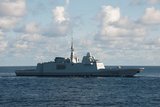Ultra-small mission computer addresses SWaP constraints
DuraCOR Pi weighs around 225g and measures 30.5 × 63.2 × 84.8mm. (Photo - Curtiss-Wright)
Aerospace and defence system integrators are continuing to create cost-effective and SWaP-efficient sensor payloads aboard crewed and uncrewed platforms, with miniaturisation of mission processor subsystems playing a key role in enabling platforms to expand their set of capabilities.
Curtiss-Wright, for instance, on 14 March unveiled a powered ultra-small form factor (USFF) ruggedised mission computer for diverse defence and aerospace applications. Called DuraCOR Pi, it weighs around 225g, measures 30.5 × 63.2 × 84.8mm and can be deployed in harsh operating environments.
David Jedynak, GM of the company’s Salt Lake City facility, explained to Shephard that DuraCOR Pi is the first ruggedised USFF produced in the embedded military
Already have an account? Log in
Want to keep reading this article?
More from Digital Battlespace
-
![Babcock nears first customer for Nomad AI translation tool]()
Babcock nears first customer for Nomad AI translation tool
Nomad can provide militaries with real-time intelligence, saving critical time on the battlefield.
-
![AUSA 2025: Israel’s Asio Technologies to supply hundreds of improved Taurus tactical systems]()
AUSA 2025: Israel’s Asio Technologies to supply hundreds of improved Taurus tactical systems
Taurus operates alongside the Israel Defense Forces’ Orion system which supports mission management across tens of thousands of manoeuvring forces, from squad leaders to battalion commanders.
-
![AUSA 2025: Kopin pushes micro-LED plans as China moves faster]()
AUSA 2025: Kopin pushes micro-LED plans as China moves faster
The plan for the new displays follows fresh investment in Kopin’s European facilities by Theon and an order for head-up displays in fielded aircraft, with funding from the US Department of Defense.
-
![AUSA 2025: Persistent Systems to complete its largest order by year’s end]()
AUSA 2025: Persistent Systems to complete its largest order by year’s end
Persistent Systems received its largest ever single order for its MPU5 devices and other systems earlier this month and has already delivered the 50 units to the US Army’s 4th Infantry Division.
-
![Aselsan brings in dozens of companies and systems under the Steel Dome umbrella]()
Aselsan brings in dozens of companies and systems under the Steel Dome umbrella
Turkey has joined the family of countries attempting to establish a multilayered air defence system with government approval in August 2024 for the effort landed by Aselsan. Dubbed Steel Dome, the programme joins Israel’s Iron Dome, the US Golden Dome, India’s Mission Sudarshan Chakra and South Korea’s low-altitude missile defence system.
-
![DSEI 2025: MARSS unveils new agnostic multidomain C4 system]()
DSEI 2025: MARSS unveils new agnostic multidomain C4 system
MARSS’ NiDAR system has been deployed using sensors from static platforms to provide detection and protection for static sights, such as critical infrastructure, ports and military bases.




























